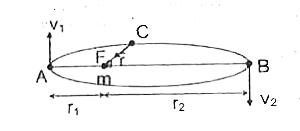The kinetic energies of a planet in an elliptical orbit about the Sun, at positions A,B and C are KA,KB and KC respectively. AC is the major axis and SB is perpendicular to AC at the position of the sun as shown in the figure. Then

A
KB<KA<KC
B
KB>KA>KC
C
KAB>KB>KC
D
KA<KB<KC
Video Solution
Text Solution
The correct Answer is:C
From angular momentum conservation, vA : maximum, vc : minimum
∴KA>KB>KC
|
Topper's Solved these Questions
- NEET PREVIOUS YEARBOOK - CP SINGHCHAPTER - NEET PREVIOUS YEAREXERCISE - Solved Questions
64 Videos
- MOTION IN A STRAIGHT LINEBOOK - CP SINGHCHAPTER - MOTION IN A STRAIGHT LINEEXERCISE - EXERCISES
128 Videos
- NEWTONS LAWS OF MOTIONBOOK - CP SINGHCHAPTER - NEWTONS LAWS OF MOTIONEXERCISE - EXERCISES
84 Videos
Similar Questions
Knowledge Check
The kinetic energies of a planet in an elliptical orbit about the Sun, at positions A,B and C are KA,KB and KC respectively. AC is the major axis and SB is perpendicular to AC at the position of the sun as shown in the figure. Then
 AKB<KA<KCBKA>KB>KCCKA<KB<KCDKB>KA>KC
AKB<KA<KCBKA>KB>KCCKA<KB<KCDKB>KA>KCA planet revolves in an elliptical orbit around the sun. The semi-major and minor axes are a and b , then the time period is given by :
AT2∝b3BT2∝(a+b2)3CT2∝a3DT2∝(a−b2)3A planet is revolving in an elliptical orbit about the sun. Its closest distance is R. If K1andK2 are the maximum and minimum kinetic energies of the planet, K1/K2=
AR/rB√R/rCR2/r2D1
Figure showns a planet in an elliptical orbit around the sun S. Where is the kinetic energy of the planet maximum?

View SolutionA planet revolves in an ellipticle orbit around the sun. the semimjor and semiminor axis are a and b. How time-period is related with them?
View SolutionIn the figure shown a planet moves in an elliptical orbit around the sun. Compare the speeds, linear and angular momenta at the points A and B.

View SolutionFigure shows a planet in an elliptical orbit around the Sun S. Where is the kinetic energy of the planet maximum?

View SolutionA planet revolves round the sun in an elliptical orbit of semi minor and semi major axes x and y respectively. Then the time period of revolution is proportional to
View Solution

